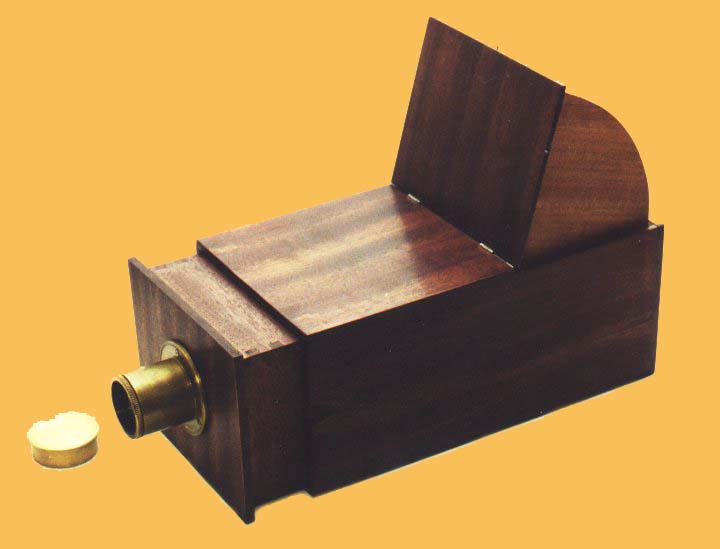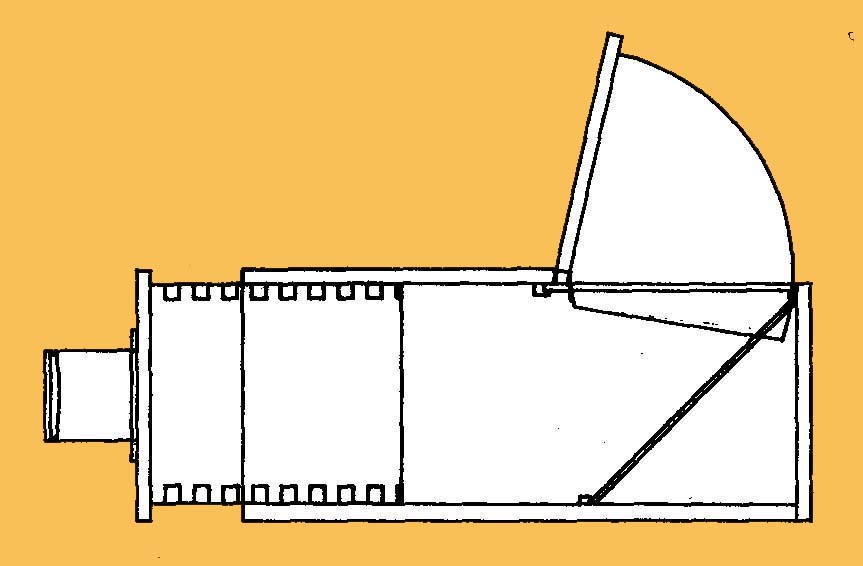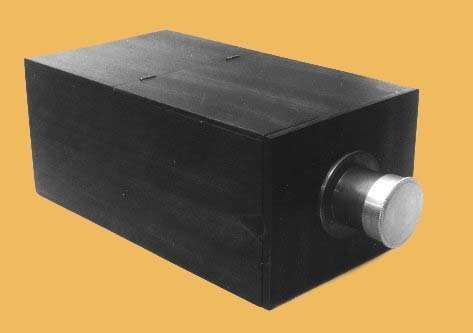| HOW TO BUILD A CAMERA OBSCURA |
|
Pre-Photography
It is
becoming increasingly difficult to find pre-photographica and if a camera obscura does
come on offer the price is usually exceedingly high. An inexpensive way of aquiring a
camera obscura for oneīs historical collection is to build it oneself. It need not coast
more than Ģ40 and it is pleasant enough job if one has access to a carpenterīs workshop
and metal lathe.
|

Homemade camera obscura. |
Pre-Studies
First
I studied the construction of the
camera obscura. amongst
others, an example in
there is, the
photographic museum in Herning, Denmark and other in the Science Museum in London. The
focal point is reached by sliding the inner box in and out until the best definition is
obtained. The lens is usually bi-convex and mounted in a turned wooden tube. Some are
rigid others are moveable to enable the focus to be adjusted. Later examples may be
mounted in brass. The combination of brass and mahogany is often an aesthetical experience
and is the reason why I chose them for mine. In 1812 Wollaston used a meniscus lens and
obtained better definition. The size of a camera obscura can vary. In Michel Auerīs
catalogue one example is reported being 285 x 155 x125 mm. These measurements fit the
later meniscus lens of 330 mm. Presumably there are no two early camera obscura which are
alike; for that reason you can choose the particular solution which suits you best. This
example is not a replica of any existing object but rather a camera obscura which might
have been built in the beginning of the
nineteenth century by a village carpenter in England.
|

Cross-section of the home-made camera obscura. |
| Collecting the materials
The most common kind of wood used in camera
obscuras are walnut and mahogany, but pine occurs and probably even oak. You can
find a pice of mahogany in a wood store or timber yard. The piece I bought measured 740 x
470 x 25 mm. It was allowed to dry out slowly in a bed of sawdust for a month.
A mirror 127 x 137 mm, and a piece of clear glass 127 x 127 mm, were bought at a
glazierīs shop. Alternatively you can use a piece of ground glass. The glazier can grind
a piece for you. At a junk market I bought a pair of old spectacles with round lenses. The
strength of the lenses was three dioptres which is the equivalent of 330 mm focal length.
Furthermore I bought a little wooden box from which I utilised the hinges and the lock
hook.
|

Lens, mounting ,stopring and cap. |
The construction
The mahogany wood was split and planed down to 7 mm. The
two slide shields lie inside the box but they can also lie on the outside. A plate spring
was placed between the shield and
the wall of
the box so that the lid does not fall down when open. The inner box is joined to ensure
good measurement stability. Both dovetail and straight joints were used. Two small hinges
allow the lid to open. A long hinge is also common to prevent the light getting in. Both
these constructions were to be found at the beginning of the nineteenth century. One important detail is the bevelling on
the front edges. It facilitates sliding the inner box in and out. A lock-hook was attached
to the back gable to enable locking the lid.
|

The inner box with lens and cap. |
| The mirror was fixed at an angel of 45 degrees in the
latter part of the box. The clear glass or the ground glass rests on two mahogany rods.
Older camera obscura have oiled paper or oiled cloth instead. With the help of a metal
lathe a mounting for the lens was turned in brass. The inside of the mounting and the
inside of the whole camera obscura was painted black. The wood was now polished. It is a
question of taste how you finish the surface. The mahogany can be stained or treated with
fumes of ammonia to give an antique appearance. Even the lensīs brass mounting can d be
aged in the same way but takes considerably less time. Test a piece of brass before you
treat the mounting. In the inside of the box you should inscribe `Replica of a camera
obscura`. |

The camera obscura ready for the journey. |
| The camera obscura is not simple to use. A black cloth may be needed to exclude
light from the side. It should not be moved while work is going on as it is difficult to
regain the right place. The focus can be adjusted to function from approximately one metre
to infinity The picture is turned sideways. |

Ten year old Evaīs drawing of her father using the
described camera. |
| START |
|





